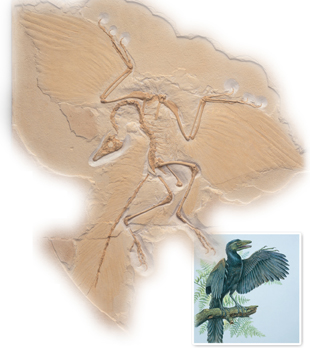Birds Today's birds are extremely diverse. Birds are reptiles that regulate their internal body temperature. They have an outer covering of feathers; strong yet lightweight bones; two legs covered with scales that are used for walking or perching; and front limbs modified into wings.  DOL•56–DOL•59
DOL•56–DOL•59
▸ Bird Roots If you've ever wished that dinosaurs were still around, you're in luck! Recent fossil discoveries strongly support the hypothesis that birds evolved from a group of dinosaurs. The first birdlike fossil discovered was Archaeopteryx (ahr kee AHP tur iks), from the late Jurassic Period, about 150 million years ago. Archaeopteryx looked so much like a small, running dinosaur that it would be classified as a dinosaur except for its highly evolved feathers. You can see a fossil and an artist's conception of Archaeopteryx in Figure 26–12. A whole series of recent discoveries of well-preserved ancient birds and feathered dinosaurs has done a lot to “connect the dots” between modern birds and their dinosaur ancestors.
▸ Bird Classification As you recall, a clade is a branch of a cladogram that includes a single common ancestor and all the descendants of that ancestor. If you look back at Figure 26–11, you will see that recognizing birds as descendants of dinosaurs should cause a change in their classification. Modern birds by themselves, the traditional class Aves, form a clade within the clade containing dinosaurs. And because the clade containing dinosaurs is part of a larger clade of reptiles, modern birds are also reptiles. The traditional class Reptilia, which includes living reptiles and dinosaurs but not birds, however, is not a clade.

FIGURE 26–12 Archaeopteryx, an Early Bird Archaeopteryx, shown both in the fossil and artist's conception, was a bird that showed both dinosaur characteristics (teeth, bony tail) and bird characteristics (flight feathers). Because of the weight of its teeth and bony tail and its small breastbone, it might not have been able to fly very well.
Analyzing Data
Feather Evolution
The information in the table shows the evolution of feathers in some groups of dinosaurs that preceded modern birds.
Organize Data Recalling what you learned about drawing cladograms in Chapter 18, use the information to place these traits correctly on Figure 26–11. (Redraw the cladogram in your notebook.)
Draw Conclusions Which type of feathers would you expect modern birds to possess?
Table of Contents
- Formulas and Equations
- Applying Formulas and Equations
- Mean, Median, and Mode
- Estimation
- Using Measurements in Calculations
- Effects of Measurement Errors
- Accuracy
- Precision
- Comparing Accuracy and Precision
- Significant Figures
- Calculating With Significant Figures
- Scientific Notation
- Calculating With Scientific Notation
- Dimensional Analysis
- Applying Dimensional Analysis





